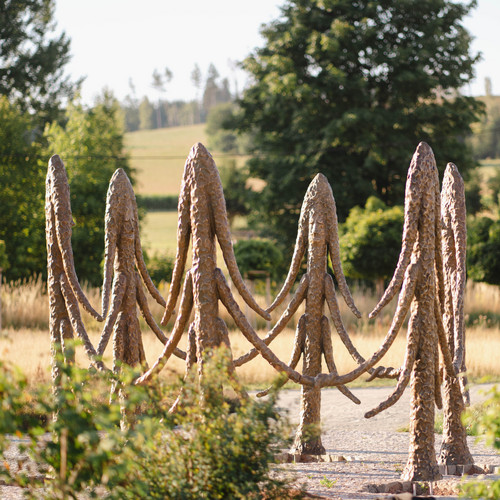Friedrich Kunath: Include Me Out
Thalheim


Seven sculptures reminiscent of stylised spruce trees with scaly bark. Six of them stand in a circle, each appearing to hold hands with the next, three branches sweeping out to either side. The sculptures have faces with lowered eyelids, pointed noses and a hint of a thoughtful smile on their narrow lips. The sculptor Friedrich Kunath, who was born in in 1974 in Karl-Marx-Stadt (now Chemnitz) and now lives in Pasadena in the US, has placed a seventh tree sculpture outside the circle. Its lowered branches somehow convey disappointment.
The artist, who works in a range of media, has named his initially humorous and playful-looking group of sculptures Include Me Out. This famous, paradoxical statement by Hollywood film producer Samuel Goldwyn immediately raises the question of where we stand in this circle, and touches on social and societal primal fears.
Situated in the Buntsockenpark, which was once the site of a hosiery factory built by Bruno Neukirchner, the group of trees is also a reminder of the concept of sustainable forestry, as described by Saxony’s chief mining officer Hans Carl von Carlowitz in his 1713 work “Sylvicultura oeconomica”. This states that only as much wood as can grow back should be removed from the forest. But today people are very worried about the millions of spruce trees – once the staple of Saxony’s and Germany’s forestry industry – that are dying from lack of water. Our man-made climate catastrophe is thwarting the sustainability strategy formulated over 300 years ago.
(Text: Alexander Ochs / Ulrike Pennewitz)
Friedrich Kunath
Include Me Out
In Thalheim, Buntsockenpark
Material: Bronze
Size: Height 2.38 m, width 3.33 m
Set up with the support of the town of Thalheim.
Address:
Buntsockenpark
Robert-Koch-Straße
09380 Thalheim / Erzgebirge
to the location on Google Maps
There is a lot to discover at the PURPLE PATH! Experience tips presented by the Tourismusverband Erzgebirge e.V.
Sustainability?
Thalheim: Breaking with tradition and innovation
Innovation has ensured the survival of the mining and industrial region of the Ore Mountains in many transformation processes to this day. Where silver mining was not successful in the 16th century, as here in Thalheim, people tried to develop other economic sectors. Due to rich forest resources and favourable watercourses in Thalheim and the surrounding area, mills, timber and textiles were established in the 17th century. The power of the mills drove sawmills and cloth mills. Weaving and lace-making followed, and hosiery weavers have been documented since 1730.
From the 19th century onwards, stocking knitting became the main industry in Thalheim. With the construction of the Chemnitz - Aue railway line in 1875, Thalheim became a boom town. At the height of industrialisation in 1925, the town had 120 factories. The Buntsockenpark, where Friedrich Kunath's sculpture ‘Include Me Out’ is located, is a place that tells the intertwined stories of breaking with tradition and innovation, sustainability and climate change. The park was renovated with funding from the European Union (ERDF) and the Free State of Saxony.
World market leader around 1900: Bruno Neukirchner hosiery factory
Bruno Neukirchner's hosiery factory once stood on the site of the Buntsockenpark on Robert-Koch-Straße in Thalheim. The entrepreneur founded the hosiery knitting factory in 1877 with two wooden knitting looms in his home. In 1890, he invested in a modern factory with steam power and electricity. From 1896, he was the first manufacturer in Germany to use modern cotton machines, a warp knitting process invented in England. By 1902, Neukirchner had expanded his production to such an extent that he became the world market leader.
The industry awarded him the title ‘Nestor of the German hosiery industry’. In 1905, his son Paul Ernst joined the company and another factory was built a few kilometres away in Oberaffalter. Around 1927, on the company's 50th anniversary, the company reached its final heyday. The founder Bruno Neukirchner died in 1936. Production came to a standstill during the Second World War, and in 1953 the family was initially expropriated, but then regained the factory. In 1954, Ernst Neukirchner gave up the company under difficult conditions. All hosiery factories in Thalheim were expropriated during the GDR era and incorporated into the VEB Strumpfkombinat ESDA.
Active tips
- Besucherbergwerk „Wille Gottes“, Bergbauverein Thalheim e.V.
- Wanderweg-Empfehlung vom Tourismusverband Erzgebirge
Innovative ability - a typical mentality of Ore Mountain doers
However, mining and early industrialisation in the Ore Mountains did not only have positive consequences. For centuries, people also overexploited nature. By the 18th century, almost the entire forest in the Ore Mountains had been cut down. The wood was needed as construction timber for the mining towns and to secure the mines, as well as firewood for smelting the ore. The hunger for wood was almost insatiable. But the resources also had to be available for future generations and the supply of wood could not be allowed to dwindle. Wood processing and paper production are still important economic sectors today.
Hans Carl von Carlowitz: The concept of ‘sustainability’
Hans Carl von Carlowitz (1645-1714), chamberlain and mining councillor to the Saxon Elector Augustus the Strong, assumed the office of chief mining administrator of the Ore Mountains in 1711. He was responsible for the supply of timber to the mines and ore smelters. He put this on a completely new footing and summarised his thoughts in a book: ‘Sylvicultura oeconomica, oder haußwirthliche Nachricht und Naturmäßige Anweisung zur wilden Baum-Zucht’ (1713). It is the first work of modern forestry. In it, he coined the term sustainability for the first time in history: the long-term and responsible use of natural resources.
With climate change, Carlowitz's concept of fast-growing spruce cultures is becoming increasingly fragile. Spruce trees cannot tolerate higher temperatures and increasing drought well. Increased pest infestation and massive storm damage are affecting the forest. The question of sustainability must be asked again.
Supplying the whole world: stocking manufacturer Carl Bruno Neukirchner
Carl Bruno Neukirchner was born on 19 December 1852 in Thalheim/Erzgebirge. As the son of master hosiery manufacturer Christian Friedrich Neukirchner, he came into contact with hosiery production at an early age. His father had been one of the founding members of the Thalheim Hosiery Weavers' Guild in 1839. In 1877, Carl Bruno Neukirchner married his wife Johanne Christiane. Nine children were born into the family, five died in infancy and four grew up: Selma, Ernst, Frieda and Alfred.
In the same year, 1877, Carl Bruno Neukirchner founded his own textile company and started with two knitting looms for the production of hosiery. By 1902, Neukirchner had developed what began as a sole proprietorship into the largest stocking manufacturer in the world. The First World War and inflation brought the company into severe economic crises. In the ‘golden 1920s’, Carl Bruno Neukirchner and his son Ernst succeeded in making their hosiery factory flourish once again: In its 50th anniversary year, the company produced 600,000 dozen pairs of stockings. Carl Bruno Neukirchner died on 17 May 1936 as a result of pneumonia.
High-performance materials for the energy sector: Krempel GmbH & Co. Pressspanwerk KG
The Thalheim site has a centuries-old history of paper mills and wood processing in the Ore Mountains. Paper production has been documented here since 1889. Around 80 employees work at Krempel GmbH & Co. Pressspanwerk KG in Thalheim in an ultra-modern paper production facility. Pressboard is manufactured in neighbouring Zwönitz.
The innovative products are supplied worldwide. They are used to insulate electrical machines and systems in the energy industry, e.g. generators, transformers and motors. The plants belong to a family-owned company with its headquarters in Vaihingen/Enz, which can look back on 150 years of tradition.
Supplying the whole world: stocking manufacturer Carl Bruno Neukirchner
Carl Bruno Neukirchner was born on 19 December 1852 in Thalheim/Erzgebirge. As the son of master hosiery manufacturer Christian Friedrich Neukirchner, he came into contact with hosiery production at an early age. His father had been one of the founding members of the Thalheim Hosiery Weavers' Guild in 1839. Bruno Neukirchner married his wife Johanne Christiane in 1877. Nine children were born into the family, five died in infancy and four grew up: Selma, Ernst, Frieda and Alfred.
In the same year (1877), he founded his own textile company and started with two knitting looms for the production of hosiery. What began as a sole proprietorship, Neukirchner developed into the largest stocking manufacturer in the world by 1902. The industry awarded him the title ‘Nestor of the German hosiery industry’. In 1905, his son Paul Ernst joins the company and another factory is built in Oberaffalter, just a few kilometres away.
The First World War and inflation brought the company severe economic crises. In the ‘golden 1920s’, Carl Bruno Neukirchner and his son Ernst succeeded in making their factory flourish once again: In its 50th anniversary year, the company produced 600,000 dozen pairs of stockings. Carl Bruno Neukirchner died on 17 May 1936 as a result of pneumonia.
Production came to a standstill during the Second World War and the family was initially expropriated in 1953, but then regained the factory. In 1954, Ernst Neukirchner gave up the company under difficult conditions. All hosiery factories in Thalheim are expropriated during the GDR era and incorporated into the VEB Strumpfkombinat ESDA.
Industrial heritage: Neukirchner Villa
The factory buildings were demolished in 2017. All that remains of the Neukirchner hosiery factory today is the associated villa. It was restored in 2010, now houses the registry office's wedding hall, seminar rooms and company offices and is a listed building.


